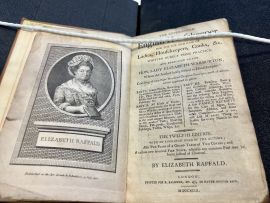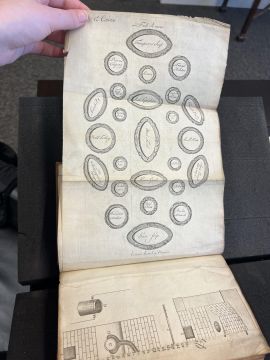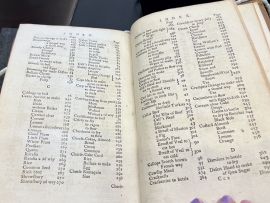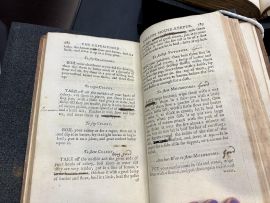The Experienced English Housekeeper

This entry analyzes six different "The Experienced English Housekeeper" by Elizabeth Raffald which are located in the Kislak Center.
The first copy was published in 1773 and is the Third Edition [1]. The second copy was published in 1786 and is the Tenth Edition. The third copy was published in 1794 and is the Eleventh Edition [2]. The fourth copy was published in 1799 and is the Twelfth Edition [3]. The fifth copy was published in 1794 and is considered the New Edition [4]. The sixth copy was published in 1798 and was also considered The New Edition [5].
Background
Historical Context & Author
As a viral book of its time, “The experienced English housekeeper” by Elizabeth Raffald iterated over the years into new editions, each time with additions in content beyond the last. Raffald’s book was officially published in thirteen different editions, spanning from 1769 to 1806. Despite Raffald’s untimely death in 1781, her publishing team continued to spin out new versions. In addition to the publications of the thirteen editions, Raffald’s book faced an active black market, leading to the creation and sales of numerous unauthorized editions worldwide. The Kislak Center houses six copies total, with publication years of 1773, 1786, two from 1794, 1798, and 1799. These copies represent the Third Edition, Tenth Edition, Eleventh Edition, and Twelfth Edition, and two copies of “A New Edition,” which fall into the category of unauthorized publications.
Author Elizabeth Raffald worked as a housekeeper in England in the eighteenth century in Doncaster, Cheshire, and Manchester, each approximately 200 miles away from London. Raffald learned the recipes and tips in “The experienced English housekeeper” while employed as a talented housekeeper and chef in these locales.
Provenance

Each copy of “The experienced English housekeeper” stored at the Kislak Center at Penn tells its own provenance story. All six copies contain a variety of ownership marks that help to trace provenance. The Chef Fritz Blank Culinary Archive and Library houses four of the six copies. Fritz Blank was a famous chef and restaurant owner in Philadelphia, and he donated several thousand cookbooks to Penn between 2002 and 2007. For the first two copies, provenance solely traces to Fritz Blank. However, for the third copy, Fritz Blank obtained the book from James Beard, the namesake of the famous James Beard Awards and pioneer of American cooking television shows. Furthermore, the fourth copy contains a signature from Frances Wood in 1826 and collector’s stamps from Alfred Berry, before arriving at Fritz Blank’s collection. The connection between Frances Wood, Alfred Berry, and ultimately, Fritz Blank is unclear. The fifth copy was donated to Penn in 2010 by collector Robert Frost, who donated a few hundred books to the Kislak Center, emphasizing British literature. Lastly, Esther Aresty donated the sixth copy. As a cookbook historian, Aresty contributed a collection of nearly 600 cookbooks with publication dates across five centuries to Penn in 1996, shortly before she passed away.
In addition to the provenance data, some of the former owners of “The experienced English housekeeper” left their marks on the books by inserting a bookplate. In particular, Fritz Blank, Esther Aresty, and James Beard included signature bookplates containing their names alongside representative images. As an interesting side note, Esther Aresty repurposes Elizabeth Raffald’s signature bookplate with her name as her personal bookplate, paying homage to Raffald. Readers can trace further ownership to booksellers through a binder’s ticket for Fox Bookbinder and a label from Corner Book Shop. Another hint of provenance can be associated with a printed dinner menu from Chef E. Bertsch, contained as ephemera inside one copy.

Publishing and Editions
Elizabeth Raffald initially published her book locally in Manchester with the support of Joseph Harrop, a printer who also ran the local newspaper, The Manchester Mercury. Soon after, with the ensuing popularity of her book, Raffald transitioned to working with Robert Baldwin, a famous publisher in London. Four of the six copies at the Kislak Center attribute publication to Robert Baldwin of Paternoster Row in London. However, the two unauthorized copies attribute publication to “W. Osborne & T. Griffin,” also located in London, but not having an official relationship with Raffald.

In place of traditional copyrighting or licensing, the bottom of the cover page in each edition says “N. B. No Book is genuine but what is signed by the Author” and “Printed for the Author.” Then, the first page of the book’s first chapter contains a cursive signature of the author. This copyrighting information is observed in the four official editions at Kislak Center, whereas the two unauthorized copies do not include any form of protective note or signature. Furthermore, the official editions describe more details regarding the publisher than the unauthorized copies, such as by listing the year of publication. Searching for these essential lines on the cover page can determine the authenticity of the specific copy of “The experienced English housekeeper.”
Material Analysis
Platform
This book object is a traditional codex featuring a quarto format with an additional nested sheet. “The experienced English housekeeper” contains signature marks on the bottom of each page which enable readers and scholars to deduce the quarto format. The signature marks serve as an alphabetic-numbering system for each quarto, such as “Q2” which assists with the printing and assembly of the book.
The book is a standard novel, with a rectangular shape that remains consistent from front cover to back cover. The text is printed on the front and back of each page. Amongst all the copies, the front of the book feels well-protected and well-preserved, with little evidence of aging throughout the past three centuries. However, upon opening the books, the aging stands out, as indicated by the yellowing and hardening of the off-white pages. In some copies, the pages face extreme wear and tear, such as the cover page in The Third Edition, which is nearly disintegrating.
Substrate
The hard cover over the book likely was made from leather, sourced from animals such as cows, goats, and sheep, which offer impressive durability, a smooth texture, and a pleasing aesthetic. In order to achieve hues of red, orange, brown, gray, tan, and black observed among the book covers, the leather must have been dyed. Despite durability, for some of the copies, the leather contains splotches with layers coming off, often leading to the addition of a protective lamination cover to preserve the fragile material.
The book’s interior contains paper, which makes sense as a popular substrate of the era. Specifically, “The experienced English housekeeper” includes nearly 400 pages of text printed in a serif font in a physically bumpy texture above the page. Upon taking a close look, horizontal lines are going across the paper, which are similarly textured, which is likely a visible weave pattern from the labor-intensive paper-making process of the eighteenth century. The exact paper-making technique and selection of fibers are unknown. Generally paper was created through a mixture of water and pulp, pressed to become flat, and, finally, dried for hours. The text is printed in black ink in a reasonable size that is spaced well. Besides the unusual textures, the paper feels typical compared to modern books.
Structure
Every copy of “The experienced English housekeeper” is bound, contemporary in the style of the late eighteenth century. Interestingly, each copy at Kislak Center varies in binding and spine designs. Specifically, the spine of each of the six copies of “The experienced English housekeeper” by Elizabeth Raffald displays a different variation upon the title and author’s name. The spines read “RAFFALD’S COOKERY BOOK,” “Raffald’s English Housekeeper,” “The English Housekeeper,” “English Housekpr. Raffald,” “English Housekeeper - Raffald - 1798,” and “The English Housekeeper - Mrs. Raffald.”

Furthermore, the design varies, with one book bound by a black spine with a gilded border and another with a green spine interspersed with thick ridges. One beautiful copy features a brown and gold binding, with decorated artistic patterns. In addition to the original binding, one book is protected by a dark brown, perfectly-sized leather bookcase. One unique structural attribute, especially for the publication era, is incorporating fold-out papers within the book. The reader can fold-out a couple of pieces of paper attached to the book’s binding, which expand to approximately the size of four individual pages. One fold-out in “The experienced English housekeeper” displays a detailed model of a fully-set dinner table, while another analyzes the functionality of cooking devices.

Navigation
Firstly, the cover page of each copy of “The experienced English housekeeper” contains a detailed overview describing the recipes in Part I, Part II, and Part III of the book, which span the entire culinary range, from proteins to baked goods to wines. However, this table of contents of sorts lacks page numbers, so it serves more as a helpful description of the contents rather than a guide to finding each page. The cover page is packed tightly together with an overwhelming amount of information. Furthermore, the page has several differences in font size accompanied by random capitalization and old English (where sometimes the letter “s” looks like the letter “f”), features that are not apparent in any other part of the book.
As mentioned previously, the book is split into parts like “Part III.” Additionally, the book is divided into chapters like “Chapter III” within the parts. Some parts and chapters begin with a wallpaper-like border design on the top of the paper, separating a new idea from prior content. For instance, the first chapter starts with a display of the author’s cursive “signature,” which is printed on either side of the title. Furthermore, one chapter begins with an ornamental first letter, while another features a stamped image of flowers in a vase. However, not all parts and chapters contain any imagery or new pages; rather, some parts and chapters begin with just a solid line page break.
The following section, “Paratexts,” describes the index in-depth. In sum, the index, parts, and chapters imply that readers stand to benefit from general and specific guidance in the process of locating a precise recipe within a book that contains over 900. The index supports speeding up the reading process, while the lack of a true table of contents and vague partitions between parts and chapters invite many readers to browse the book at their leisure.
Paratexts

“The experienced English housekeeper” contains multiple paratexts. Firstly, each edition has an extremely detailed index, consisting of fourteen pages. The index is very specific and functions like a grocery store catalogue, listing every imaginable ingredient. Furthermore, most ingredients expand into multiple sub-entries, for example, under the entry entitled “biscuits.” While the index does not indicate an author, the reader can infer that Elizabeth Raffald wrote it as a guiding tool for readers.
Two pages of advertisements follow the index, enabling the publisher to suggest similar books available around the same time. Each listing includes the book’s price and a high-level summary of its contents. For the editions published by Robert Baldwin, the advertised books come from his collection at Paternoster Row in London. Therefore, the advertisements are likely authored by the publisher himself. After the advertisements, the reader encounters one sheet of blank endpaper before reaching the back cover.
Book Use
Marginalia & Marks

According to the local notes data provided by Penn Libraries, several copies of “The experienced English housekeeper” contain marginalia and annotations. While the marginalia and annotations do not explicitly reference authorship, it can be inferred that most marks come from the book owners, who reviewed the included recipes as they cooked them. In one copy in particular, the owner deployed an internal rating system, writing next to the recipes feedback like “Good!” and “Very good,” an antiquated version of the rating systems used today by chefs on social media and on mobile cooking applications. One copy contains an author’s mark next to the reviews, such as saying, “This is very good,” followed by illegible initials. Other times, an author may suggest adding missing ingredients to a recipe, such as ginger. Lastly, the reader observes random doodles in the margins of some copies. Such marginalia and annotations suggest an interactive reading process in which the reader contributes opinions and perspectives alongside the author. The author’s opinion is tested, opposed, and approved.
Unfortunately, beyond the marginalia and annotations, most of the ephemera contained in the copies of the book have been removed from Penn Libraries and stored separately, such as handwritten recipes, photocopies, correspondences, book dealer descriptions, and a child’s letter.
Additionally, asemic marks are extremely common throughout one copy of “The experienced English housekeeper” in which the book owner edited the included recipes to reflect personal preferences beyond the reviews referenced above. With many owners as famous chefs themselves, it makes sense for experimentation and revision of the traditional recipes from the eighteenth century, both in terms of technological advancement and changes in palettes. For example, in one copy, the owner crossed off some of the information contained in the recipes. Upon checking with other copies of the same book, it became apparent that the owner crossed out “cloves and nutmegs,” specific ingredients in a recipe.
Audience, Readership, & Circulation
Historical Significance
Gender and Literature
Raffald defines her target audience on the cover page of “The experienced English housekeeper” declaring her book is “For the USE and EASE of Ladies, Housekeepers, Cooks, &C.” She supports this claim with an explicit dedication to the Honorable Lady Elizabeth Warburton, Raffald’s most recent housekeeping client. After that, the book contains a substantial preface, likewise dedicated to Warburton. The dedication and preface are both clearly from the perspective of Raffald as they describe her personal experiences as a housekeeper for Warburton. Unlike other books of the time, Raffald writes as a woman, dedicated to a woman, and for a target audience of women.
Cultural Implications
Such organization is essential because each copy of “The experienced English housekeeper” contains over 900 recipes, a massive collection, especially considering that cookbooks were not as common at the time. Many of these recipes were usually passed down within families, so a publication compiling them together served as a groundbreaking way to share cooking knowledge that previously never appeared in print. Readers can identify the beginning of each new recipe as marked by a capitalized verb like “TAKE” or “GATHER” which then proceeds into a paragraph of details.
References
- ↑ Raffald, Elizabeth, and R Baldwin. The Experienced English Housekeeper. London: Printed for the author, and sold by R. Baldwin, No. 47, in Pater-Noster-Row, 1773. https://franklin.library.upenn.edu/catalog/FRANKLIN_9962183703503681
- ↑ Raffald, Elizabeth, and Robert Baldwin. The Experienced English Housekeeper. London: Printed for R. Baldwin, 1794. https://franklin.library.upenn.edu/catalog/FRANKLIN_9976201983503681
- ↑ Raffald, Elizabeth, and R Baldwin. The Experienced English Housekeeper. London: Printed for R. Baldwin, 1799. https://franklin.library.upenn.edu/catalog/FRANKLIN_9962129733503681
- ↑ Raffald, Elizabeth, William Osborne, and T Griffin. The Experienced English Housekeeper. London: Printed for W. Osborne and T. Griffin, 1794. https://franklin.library.upenn.edu/catalog/FRANKLIN_9947852523503681
- ↑ Raffald, Elizabeth, William Osborne, and T Griffin. The Experienced English Housekeeper. London: Printed for W. Osborne and T. Griffin, 1798. https://franklin.library.upenn.edu/catalog/FRANKLIN_9947825983503681